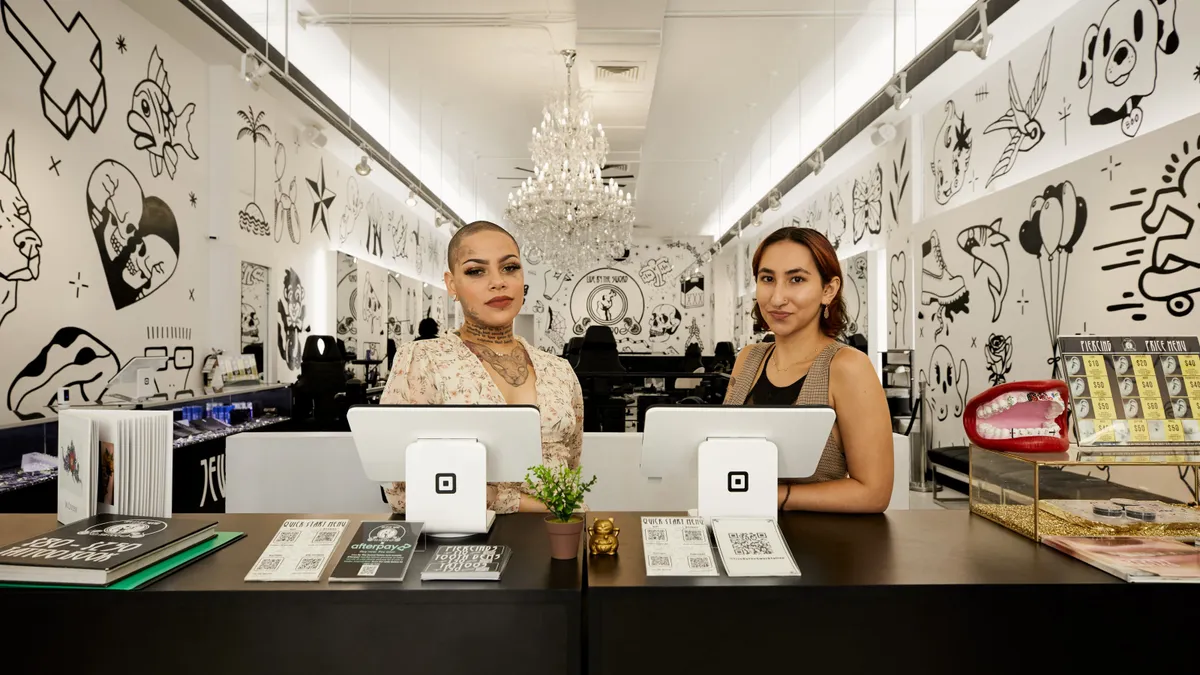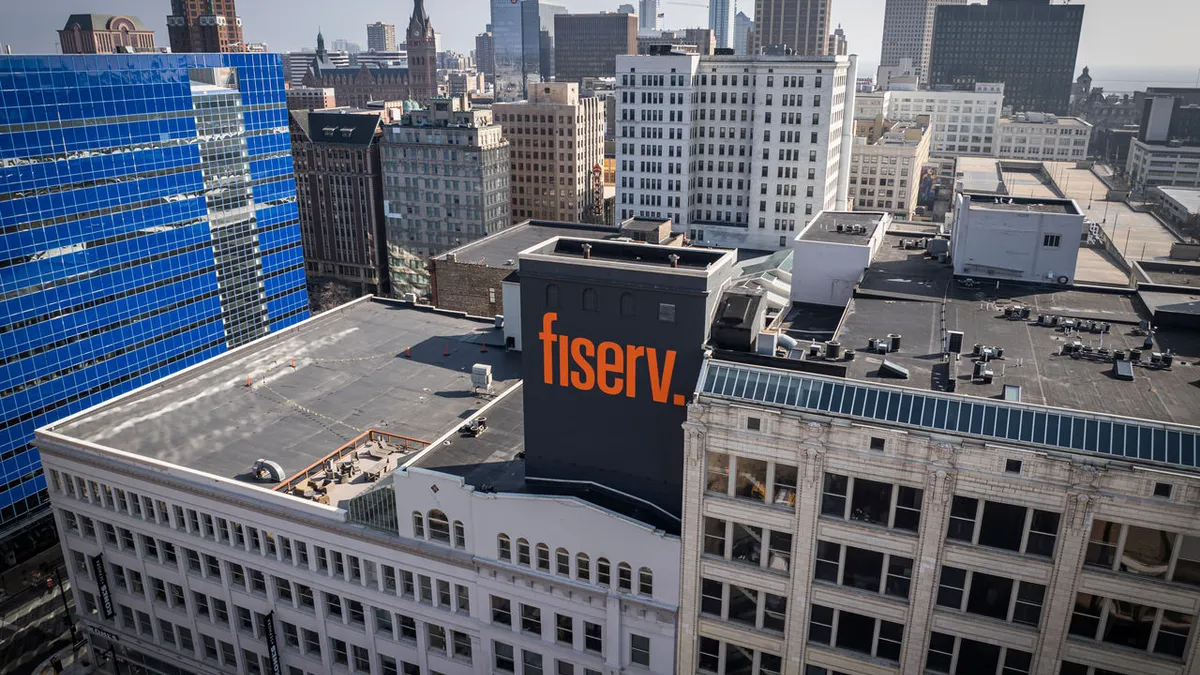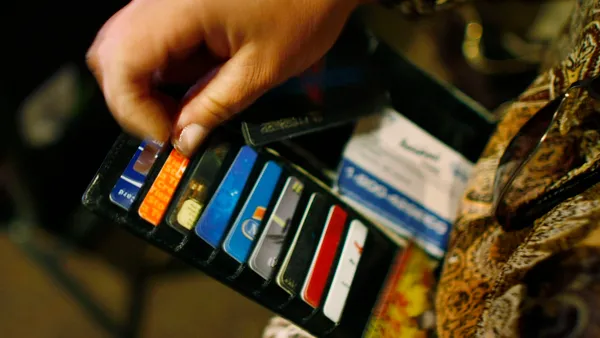Margaret Sheils says she knows enough to know she needs a credit card, but the Gen Zer takes a cautious approach to using it.
"For me, that’s just always been a fear, of spending money I don’t have," said Sheils, 24, who lives in Chicago. She tried using the trendy buy now-pay later option for a purchase once, but "I’d rather only buy something if I know I can afford it right now."
That debt-wary attitude is one of a number factors behind Gen Z’s much-hyped relationship with credit cards, but industry analysts say this generation is gravitating toward them as they mature. Gen Zers themselves say they’re not afraid of or uninterested in credit cards – they’re just mindful about how they use them.
About half of Gen Zers currently have a credit card, but a similar portion of that age group — born between 1997 and 2012 — can't qualify under traditional scoring methods because they lack sufficient income. Each generation’s relationship to credit has been unique, and although the Credit Card Accountability Responsibility and Disclosure Act of 2009 has had some effect on Gen Z's relationship with credit, this group of young consumers is expected to turn to credit products more quickly than their millennial predecessors, who were delayed by the Great Recession.
Bankrate.com senior industry analyst Ted Rossman said many Gen Zers are realizing there’s a need to establish credit, whether for an apartment lease, a mortgage or a car loan. "The real sort of catch-22 is that it takes credit to get credit," Rossman said.
Gen Zers are coming around to credit cards, but "it’s a little bit of a different path than the older generations followed," Rossman said.
Generational differences
One influence on Gen Z’s current relationship with credit cards is the Credit Card Accountability Responsibility and Disclosure Act of 2009, which introduced more hurdles for those under 21 trying to get a credit card, like a cosigner or income proof requirements.
It also barred card issuers from soliciting on college campuses, causing companies like Capital One and Citi that did heavy student marketing to pull back. "You have a different foundation there for a lot of students," said Brian Riley, director of Mercator Advisory Group’s Credit Advisory Service.
Since that change, consumers under 21 have had a harder time developing credit. "That does create that two- to three-year lag for those consumers," said Paul Siegfried, the leader of TransUnion's credit card business.
Gen Z is defined as those born between 1997 and 2012, according to Pew Research Center, making older Gen Zers 18 to 25 years old.
Rossman said 55% of Gen Zers have credit cards, compared to 66% of millennials, 77% of Gen X and 85% of baby boomers, indicating a "steady stair-step up."
A number of factors influence those generational differences, from personal preference to access to credit. The CARD Act has had lasting effects even beyond age 21 for generations like millennials and Gen Z.
Still, "there’s every expectation that the set of all people who are Gen Zs will start getting credit cards, no doubt about that," said David Robertson, publisher of The Nilson Report.
Relationships to credit have varied by generation, Siegfried pointed out. Baby boomers got their first credit card – a novel idea – at a retailer, while Gen X was offered free T-shirts on college campuses for filling out credit card applications.
When Siegfried’s baby boomer parents got their first credit card, from Sears, "that was huge for them, to be able to get access to a credit card, this renewable credit deadline," he said.
By the time Siegfried came of age, "you’re getting solicitations. It’s not something weird; it comes to you in the mail and you just respond to it," he said. "This access to credit, generationally, has come a long way."
What sets Gen Z apart
Whereas many Gen Xers and some millennials got their first credit card in college, this milestone is occurring later for many Gen Zers, but so are other major life events, like buying a house, getting married or having children.
One reason for those delays: student loan debt, which weighs heavily on this generation. Robertson said it’s "unquestionably" the biggest issue facing Gen Z, as these consumers enter what should be prime borrowing years.
That’s exactly why Sheils said she’s uninterested in burdening herself with more debt. "For a lot of us, I think student loan debt kind of informs the majority of our financial decision-making," Sheils said.
There’s something to be said, too, for generations that came of age during the Great Recession or the COVID-19 pandemic and witnessed older siblings or parents struggling financially, Rossman said.
"A lot of Gen Zers in particular view credit cards as debt instruments," Rossman said. Where millennials have embraced the rewards and perks of credit cards, "to a lot of Gen Zers, it’s like, whoa, I’m not even going to go there, and it just scares me."
Sheils said she’s considered signing up for another credit card, "but I just think that maybe I’m not there yet mentally. The thought of having another stresses me out."
Before she goes out for drinks or a meal, Sheils checks her bank account balance and looks at menus to calculate what she’ll spend on food and drink. She has one credit card and uses it for gas and purchases related to her dog, because those are two substantial expenses she has to be able to pay.
With her more cautious, practical attitude about spending, Sheils is far from alone among her peers. Sonya Lutter, director of research and education at consulting firm Herbers & Company who spent about two decades in higher education teaching financial therapy, said she sees Gen Z using credit cards "really responsibly."
It's a lot more nuanced than Gen Z liking or disliking credit cards. "They’re really fine taking on a credit card, if they see some value to themselves. And if it’s just the company that’s saying they need it, that’s not going to influence them," Lutter said.
Gen Zers are highly intuitive with technology, are values-oriented and prize diversity, and use peer-to-peer payment apps like Venmo or Cash App heavily, Lutter said. They also have more fluid attitudes, often lacking the brand loyalty older generations exhibit and following what their friends are drawn to, she said.
Money lending is a familiar concept, but the approach has to be a bit different with Gen Z. Salman Syed, general manager of North America for virtual card company Marqeta, said the way brands engage with Gen Zers — who'd rather text than talk by phone, for example — is crucial. "What’s so core here is how you establish that relationship and how you speak to them," he said.
Coming around to credit
Gen Z has no shortage of payment options, but those able to get credit cards appear to be turning to them in bigger numbers. Data indicate Gen Z is now leading the way in terms of growth rates, Siegfried said, and they seem "savvy," in terms of their access to and usage of credit.
Credit card originations in the third quarter of 2021 were up 63.5% year-over-year, reaching a record 20.1 million new accounts, according to TransUnion data. That rise came as card companies boosted marketing in the wake of the COVID-19 pandemic to reverse a decline in usage, with some particularly pleased about young consumers.
Gen Zers accounted for 3.1 million card originations in that quarter. Comparatively, in the third quarter of 2020, Gen Z logged 1.8 million originations, per TransUnion. To Siegfried, that growth indicates Gen Z continues to take part in the credit business.
Growth in originations drove up the number of credit card holders to 196 million in the fourth quarter of 2021, according to TransUnion, and Siegfried expects Gen Z to lead the charge on growth for the next two decades.
The Great Recession affected millennials’ use of credit, Siegfried said, with the average millennial getting similar credit products 3 to 3.5 years later than their Gen X counterparts. Siegfried expects Gen Z will turn to credit products more quickly than millennials.
While card industry observers tend to expect young adults may delay adoption of credit cards, it's more a question of when they'll embrace them, as opposed to whether they'll do so.
"That’s definitely what we saw with older millennials," as they established their careers and families, and the perks of credit cards began to appeal to them, Rossman said. "Gen Zers will eventually climb on board in greater numbers as well."
Yusuf Aljabri, 20, who lives in Chicago, said he got his first credit card, a student card, this year and has started to use that for smaller purchases, like food or clothes, that can be paid off easily. "If I can just pay for it at the moment, then I just kind of do it, so I don’t have to worry about the expense later on," he said.
"Gen Z, I feel like, is becoming more financially aware and financially literate," Aljabri said. "I see a lot more people getting credit cards and using them responsibly as well."
About half of Gen Z currently can’t qualify for a credit card under traditional scoring methods, Robertson noted. "They just don’t have the kind of cash flow to make that happen," he said. Many are "thin-file" consumers, meaning they have little to no credit history, and there’s been a recent push to bring more of those people into the credit pool.
However, if a large percentage of Gen Z remains plagued by out-of-control student loan debt, there’s "a distinct possibility" that a decade from now, an outsized share of that generation will remain in the subprime borrower category, Robertson cautioned.
The draw of BNPL
Gen Z doesn’t yet possess significant purchasing power, but it’s an age group that wields sizable influence over consumer thinking. In recent years, the consumer mindset has changed tremendously, "fueled a lot by Gen Z," said Chiro Aikat, Mastercard’s executive vice president of North America products.
Gen Z, a generation that demands seamless, digital experiences and expects the ability to check account balances as often as they’d like, is all about, "'I don’t want to think about my payment. I don’t want the way I pay, and how I pay, to drive what I want to buy. I want my buying to be top of mind, and then I want the other things to flow in,'" Aikat said.
That’s only part of what’s fueled the generation’s interest in buy now-pay later options. Younger people also tend to be more willing to try something new than older generations. And the ability to spread a purchase across multiple pay periods is understandably attractive for a 24-year-old consumer who "doesn’t have massive amounts of liquidity," Siegfried said.
Siegfried believes BNPL is being used more as a cash flow tool rather than a debt management tool. As to whether data show credit cards are being replaced by BNPL, Siegfried said "I haven’t seen evidence that that has occurred."
Gen Z’s current interest in BNPL or debit cards may just be a function of age. In another five to 10 years, as they establish careers, increase their credit-worthiness and have more desire for credit, experts said, it’s likely their priorities will shift.
Oftentimes, there is a link between BNPL and credit cards anyway, with consumers using a card to make their installment payments. Rossman said the vast majority of BNPL users have credit cards, too; "they just decide to use BNPL selectively." BNPL and debit cards are formidable competitors to credit cards, "but over time, it’ll be more of an 'and' as opposed to 'or,'" Rossman said.
Gillian Manning, 21, of Coconut Creek, Florida, has used PayPal Credit and now has a credit card through a bank, which she uses mainly for groceries and smaller purchases she can pay off quickly. She said she deals with financial anxiety and while BNPL would have appealed to her in years past, "I’m hesitant to do that now, because I don’t want to take on any more debt." "I try to be as fiscally responsible as possible," she added.
That kind of gradual development in payment preferences is what's likely to keep young people moving in the direction of cards, said Charlie Youakim, CEO of BNPL company Sezzle. BNPL is "the perfect training wheels for credit" because it helps younger consumers start to understand how to manage debt and pay it back, but he expects Gen Z will eventually adopt credit cards. "I just don’t see how you can argue against credit cards," he said.
More competition for card companies
The plethora of options facing Gen Z has spurred traditional card industry players to introduce new offerings to remain competitive with neobanks and fintechs.
Rossman pointed to American Express’s recent addition of a debit card linked to a checking account, with part of the company’s reasoning being "the young adult angle."
With 70% of new American Express cards acquired in the fourth quarter last year going to millennials and Gen Z, skepticism related to premium cardholder potential among those age groups "is over," Amex CEO Steve Squeri said during a company earnings call this year
The company would not share data solely on Gen Z, but a key part of Amex’s growth strategy involves “enhancing and expanding our benefits and features, with a focus on appealing in particular to younger customers,” Amex Communications Director Azar Boehm said in an email.
Discover CEO Roger Hochschild has also said BNPL isn’t taking away from credit cards. "I totally reject the idea that younger consumers can’t manage credit – it’s a myth. We’re seeing higher take-up rates for credit cards in the latest generation of students," Hochschild told American Banker.
Student cards, which are for those consumers who are at least 18 years old and might require proof of enrollment in school, continue to be a focus for the company, a Discover spokesperson said. He declined to say how many such cardholders there are.
Aikat said the vast majority of consumers don’t see payments as card/non-cards; they just want to be able to pay when they want and how they want. For its part, Mastercard expects to roll out Mastercard Installments this spring to join the BNPL trend.
Mastercard’s "entire strategy is about choice. It’s becoming more about choice, than the rails on which that payment happens," Aikat said.
Visa, too, is introducing BNPL, with Visa Installments. It's moves like these, incorporating new trends, that card companies and marketers may need as they try to attract Gen Z. Adding cryptocurrency services is another way in which they're attempting to draw in younger generations, given their affinity for that rising digital alternative.
"Increasingly, young adults are kind of outside the traditional financial system, so they might be playing by somewhat different rules," Rossman said.
BNPL providers don’t have the baggage other lenders might have accrued during the Great Recession, Syed noted, "but I also think they just know how to appeal to this generation a lot more." BNPL lenders stress the stark contrast between their products and credit cards’ interest rates and fees.
Appealing to Gen Z is a top priority for card issuers, given the importance of customer acquisition and retention. Companies are eager to be the first to give young people credit cards because so many tend to stick with a card company for years to come, Robertson said, although Gen Z’s notions of loyalty may differ from their parents.
Not surprisingly, considering Gen Z’s youth, it's an age group that's still sorting out what it's interested in and what it finds enticing about credit cards. Rossman said it's more of a mixed bag as to what credit card features draw in these young consumers. "There is a lot of diversity of ideas there," especially as they show interest in novel things like crypto rewards or cause-oriented perks, he said.
That diversity of ideas is just one reason Gen Z is likely to keep card companies and traditional banks on their toes in the years to come, Rossman said. These consumers have a plethora of payment choices, and that heightened level of competition means it’s game on for card stalwarts as companies seek to attract those maturing customers.
"They definitely would like to get their hooks in you early and grow with you," Rossman said. The challenge facing established players right now: How do you foster these relationships and then grow with these consumers, while fending off newer fintechs?
Those fintechs and BNPL providers have amassed young customers and are building out their offerings. As the new entrants strive to grow with their customers, they're angling to "show that credit is a really valuable offering" in these new forms, Syed said.
"It's an interesting time, because financial relationships may not be as steeped as they've historically been," Syed said. Traditional credit providers and new players alike will have to work harder to draw and keep their young clientele.



















